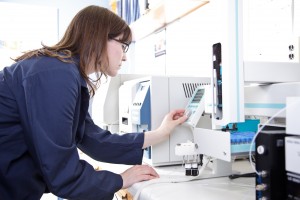Every so often a client comes to us with the request to re-do analysis completed by another testing lab. This is often requested because they are either questioning results or are dissatisfied with the poor results. We had a case like this recently that involved Size Exclusion Chromatography Analysis (also known as Gel Permeation Chromatography) with multi-angle light scattering detection (SEC-MALS). When reviewing the previous analysis, we realized there were fundamental errors that contributed to the poor results.

First and foremost, SEC analysis is a science. There are basic steps that must be taken to ensure reliable results. The science component must be supplemented with an inherent understanding and appreciation for the complexity of SEC analysis – it is also an art. Critical components to successful SEC analysis can be characterized by three factors: the expertise of the scientists, the quality system of the testing lab, and the work style of the testing lab.
Expertise of Employees
Selection of Proper Columns
Is the molecular weight separation range appropriate for your sample? If you use a column set with an exclusion limit that is too low for the samples, part or all of the sample will elute in the void volume and not be properly separated. That will result in erroneous molecular weight values.
Selection of the Right Mobile Phase to Minimize Interactions
By mobile phase we mean the solvent that is flowing through the column. With SEC you want to make sure that your sample is not interacting with the columns, or you can get erroneous results. In the extreme, part or all of the sample will stay on the column rather than reaching the detectors. You need to be “on your toes” to recognize when adsorption on the column is happening. Better yet, select a mobile phase that doesn’t allow that to happen in the first place. This is one of the components that makes SEC not only a science but an art as well.
Selection of the Correct dn/dc Value
This value is the specific refractive index increment. It is a critical value for light scattering molecular weight calculations. It is something that is specific to the particular polymer and solvent combination that you are using. It must be measured correctly in order to get accurate results from SEC-MALS. Using an incorrect dn/dc value is a common mistake made by those without proper experience.
A Robust Quality System
Ensure the Detectors Used are Properly Calibrated
This must be done to ensure reliable and accurate results.When performing SEC-MALS, an error in the MALS or refractive index (RI) detector calibration constants will result in a proportionate error in the calculated molecular weights. Detectors must be calibrated properly and calibration constants must be handled correctly with a firm understanding of the science behind the measurement technique. Calibration constants can drift over time, so it is important for the laboratory to have a program in place to monitor the calibration constants and to recalibrate as necessary to ensure accurate results.
Service Contracts on Instruments
Investing in full service contracts on instruments to ensure they are proactively kept in pristine condition is money well spent. This keeps firmware and software up to date as well as ensuring critical hardware updates are implemented. Instrument performance can deteriorate over time as components age. This is especially true with light scattering detectors, where the flow cell can become fouled, resulting in an increase in stray light and distortion of the MALS chromatograms. Pump pistons and seals can wear out over time, resulting in variability of flow rates and retention times. It is essential to proactively maintain SEC equipment to ensure reliable and accurate results.
In-House Equipment Qualification Programs
We are talking about all the “Q’s”–IQ, OQ, & PQ (installation qualification, operational qualification, and performance qualification). IQ ensures that the instrument is installed correctly in an appropriate environment. OQ ensures the instrument operates correctly in its installed environment, as required for its intended use. PQ performed at regular intervals, ensures the equipment is functioning correctly when we run a client’s samples. Additionally, there should be an effective system in place for equipment change control. This is expected by the FDA for testing of polymers that are used in medical devices and pharmaceutical applications.
Comprehensive data review and approval process Review of all raw data, data entry, calculations, and reports by a second person with relevant experience helps ensure that the data delivered to the client is accurate and reliable.
Inherently Collaborative
Client Collaboration Counts
Results are more than just data. Data isn’t helpful if it doesn’t get at the question being asked or the need that was the impetus for testing. A lab that is inherently collaborative and conversational will always better meet the needs of the clients. Also, seek out a testing lab that can develop and validate custom test methods. We work with clients and understand what they need and are trying to do. If the results aren’t relevant then what good are they?
An Internal Teamwork Approach
We all have strengths and weaknesses, and no one person knows everything. A lab with a wide range of skills and expertise in different topics with a collaborative approach can work together to solve complex problems. Discussions of challenging projects with other team members not directly involved often yield an innovative approach or a new path forward that was not obvious at first glance.
